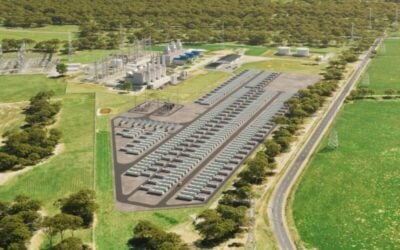
New York Power Authority (NYPA) has started a process of adapting sites that host fossil fuel powered peaker plants in its service area to host battery storage which could replace them.
NYPA, which serves around a quarter of the state of New York’s electric load, today issued a Request for Proposals (RfP) that could lead to four-hour duration battery energy storage systems (BESS) being installed at those sites.
Enjoy 12 months of exclusive analysis
- Regular insight and analysis of the industry’s biggest developments
- In-depth interviews with the industry’s leading figures
- Annual digital subscription to the PV Tech Power journal
- Discounts on Solar Media’s portfolio of events, in-person and virtual
The RfP comes as part of an ongoing push towards clean energy, as outlined in the public power organisation’s long-term strategic plan. NYPA wants to serve emissions-free electricity to all its customers by 2035 — five years ahead of a New York State target date for achieving a zero emissions electricity sector.
It also comes in recognition of the fact that many of New York’s urban peaker plants are located in areas which are home to the state’s most disadvantaged communities.
In October 2020, ahead of the publication of its VISION2030 strategic plan two months later, NYPA began a collaboration with the PEAK Coalition, a group of clean energy and environmental justice groups, to see how a fleet of about 400MW of gas-fired peaker plants — so-called because they are only called into action to meet energy demand at peak times — could be transitioned to cleaner options.
The six simple combustion turbine peaker plants were opened just after the turn of the millennium in 2001, dubbed with the now perhaps ironic title of Small Clean Power Plants (SCPPs).
Each runs on average for only about 10% of the hours in a year, but despite this low capacity factor can contribute significantly to air pollution as well as greenhouse gas (GHG) emissions levels.
The sites’ land and electricity infrastructure could instead be used to host BESS facilities which could do the same job without the heavy environmental and increasing economic costs.
“To meet New York’s clean energy targets, we need a multifaceted approach that includes creative solutions such as battery storage and innovative adaptation of our current infrastructure to meet the energy demands of tomorrow in a cleaner way,” NYPA interim president and CEO Justin E. Driscoll said.
New York State also has a 6GW deployment target for energy storage by 2030, a large portion of which NYPA and other state utilities will need to provide.
Polluting sites can be leveraged to expedite clean energy transition
A study commissioned on behalf of NYPA has just been published by analysts Energy & Environmental Economics (E3) and power engineering company GE, which consulted with the PEAK Coalition and clean energy consultancy group Strategen.
It will be technically and economically feasible to replace the peakers with renewables and four-hour batteries by 2030, the Small Clean Power Plant Adaptation Study finds. This will be made possible by the converging trends of renewable energy generation in New York increasing and technology improvements and the falling costs of battery storage.
This wouldn’t have been the case just three years ago, the study found, because although most peakers only run for about 10% of the year, there were several days, mostly in summer peaks, when the gas plants were running continuously for 8 hours or more at full output.
Tied to New York’s Clean Energy Standard, which will require 70% of electricity consumed in the state to be renewable by 2030, the frequency and duration which the peakers will need to run for both decrease and battery storage can help meet the gap.
“As the State moves ahead with offshore wind, solar and transmission projects that will deliver more clean energy to New York City, NYPA is encouraged by the modelling and forecasting in this collaborative study that shows that we may be able to expedite our transition to cleaner energy technologies at our in-city plants, providing that we can continue to ensure a reliable, resilient energy system for New York City,” Driscoll said.
The RfP is currently tentative. NYPA wants to assess the options in response and develop a strategic roadmap for how to adapt the SCPPs, which will be published by the end of this year.
Bids are due by 24 May 2022 and potential awards will be announced at the beginning of July. More details on that can be found at the NYPA Procurement website here, while the Small Clean Power Plant Adaptation Study can be viewed in full here.
Can all 6GW of NYC peakers be replaced?
The fleet represents only a small portion of the entire state’s peaker plants but the SCPP adaption process could be a significant start for NYPA. Around 75% of NYPA’s load is served by hydroelectric plants, so it needs to take immediate action to decarbonise the remaining 25%.
NYPA also owns the land which used to host New York’s most pollution-heavy power plant ever, the 885MW natural gas and oil-fired Charles Poletti Power Plant, which closed in 2010. Already in development at the site is a 100MW/400MWh (4-hour) battery energy storage system (BESS) project.
Developer 174 Power Global, a Hanwha Group subsidiary, was handed regulatory approval for the project in July 2021 and is being leased the land by NYPA. In an interview with Energy-Storage.news last year, NYPA chief commercial officer Sarah Orban Salati discussed that project and a range of other initiatives and options ahead in the clean energy transition.
A previous study commissioned by PEAK Coalition and authored by Strategen, published in March 2021, found that a combination of renewable energy, energy efficiency and energy storage could enable retirement for New York City’s entire 6GW fleet of peakers, albeit it would require several gigawatts of each technology.
Some of those plants run on even more polluting fuels like heavy fuel oil and kerosene. Peaker plants contribute nearly all (97%) of New York State’s nitrous oxide emissions and New York residents paid around US$4.5 billion to operate them over the past decade.
PEAK Coalition’s membership includes New York Lawyers for the Public Interest and the New York City Environmental Justice Group and three other organisations.
A March 2019 article for this site and our journal PV Tech Power investigated the wider potential for solar-plus-storage peaker plants.






